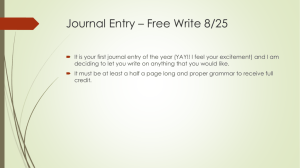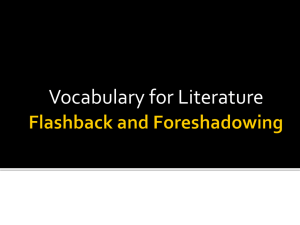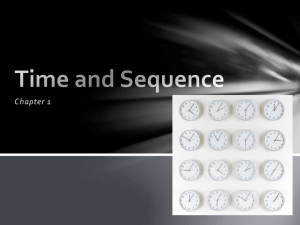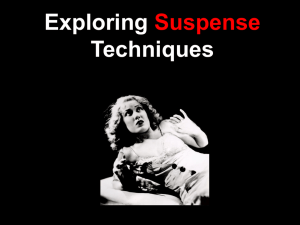Story Devices
advertisement
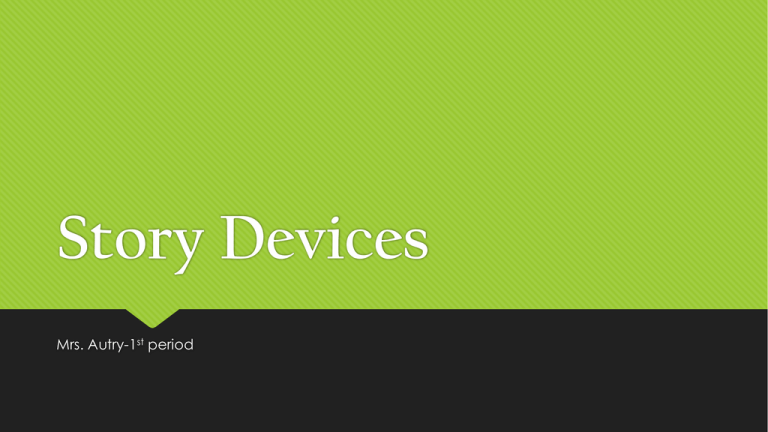
Story Devices Mrs. Autry-1st period Task You need…your notebook, 4 different colored pencils or crayons. Turn to page 34 in your notebook. Color the 4 ipods…each one a different color!! Short Stories Let’s think about the stories we’ve read so far… Priscilla and the Wimps The Landlady Lamb to the Slaughter Little Brother Which one did you enjoy the most? The least? What made the stories enjoyable? Think about Little Brother… “You’ll do no such thing.” Mommy said. She grabbed his arm and spun him around. The spanking would come next. But it didn’t. Instead he felt her fingers searching for something at the back of his neck.” In this story, we do not know how the story is going to end. Is Mommy reaching for a switch? If Peter also a Little Brother? This is an example of a cliffhanger. Cliffhanger Let’s write the definition on the ipod. Cliffhanger… An ending to a section, chapter or story that leaves the reader in suspense. Here’s an example… Cliffhanger https://www.youtube.com/watch?v=qlz3bZIMjlc Cliffhangers lead to… Cliffhangers leave the reader/audience thinking about what is going to happen next, AND wishing they knew what would happen next!! Are the Duplos going to take over lego land?????? Cliffhangers create a feeling of anxiety…what’s going to happen next???? Therefore, cliffhangers lead to… SUSPENSE Suspense Let’s write the definition on the ipod. Suspense… The anxiety the reader feels about what may happen next Here’s an example… Suspense https://www.youtube.com/watch?v=WP3J7Tu1oi0 Cliffhangers and Suspense Both of these are called Story Devices. Let’s define this… Techniques writers use to make a story more interesting and enhance the experience for the reader. 2 other Story Devices: Foreshadowing Flashbacks Let’s explore those!! Foreshadowing and Flashbacks Foreshadowing definition… Hints or clues suggesting what may happen later in the story Let’s watch… https://www.youtube.com/watch?v=LRVR xvNYR7Y Flashbacks definition… Interrupting the plot of a story to recreate an incident of earlier times Let’s watch… https://www.youtube.com/watch?v= nl1EzrlIHl4 Review You’ve learned about/reviewed the following devices: Cliffhanger Suspense Flashback Foreshadow Review Story devices are Techniques writers use to make their stories, movies, shows, cartoon, etc. more interesting and enhance the experience for the reader/viewer. Your Task Today, you will explore these 4 techniques more in depth!! You will read some examples of the devices as well as provide some of your own. You will also fill out a chart with some information from this presentation. So, let’s start by making the chart….that’s right…you are making it!! #autryissavingpaper Notebook Device Turn to page 42 in your notebook. 1. Cliffhanger At the top, in marker, label Story Devices. 2. Suspense Next, make and label the chart you see next. Oh, you have messy handwriting and line drawing skills? That’s ok…use a ruler. 3. Foreshadow 4. Flashback Definition (Own Words) Why it Works Example (Summarized) Cliffhanger: What is It? A cliffhanger is a type of device in which the end is curiously abrupt so that the main characters are left in a difficult situation without offering any resolution of conflicts. Cliffhanger: Why it Works! (Summarize these points.) Cliffhangers really help out authors and movie/show directors. #theyaregettingpaid This device ensures that readers will buy the next installment in order to read and find out what happens, or watch the next show/movie. Cliffhanger…Did You Know? A successful story conclusion leaves the reader feeling satisfied, but if you want to write a sequel to your story, add a cliffhanger to make your reader eager to read more. The term cliffhanger comes from old movies which were serials. The end of each segment left the hero or heroine in a dangerous situation -- sometimes literally hanging off a cliff. Descriptive scenes, dialogue, and questions are all devices that can be used in creating effective, successful cliffhangers. Cliffhanger: Example Give an example of a cliffhanger from a movie, story or show you are familiar with. Write a summary of this in your chart. (Make sure to include the title of the book/movie/show!! If you are not familiar with any, you can search for one on the internet (YouTube works fine-provide a summary in the chart and the video name.) Bring me your notebook so I can make sure you are completing your chart correctly! Suspense: What is It? Suspense is a feeling of anxiety or anticipation. In literature, authors use that anxiety to make readers concerned about characters with whom they have formed sympathetic attachments. Suspense: Why it Works! (Summarize these points.) Through suspense, authors/directors can create scenarios that force readers to continue to read in order to understand or see what may happen to their beloved characters. Suspense ensures the reader will have enough interest to continue reading or watching throughout the piece. If the author/director has done his job, suspense will continue to increase up until the final confrontation and turning point. Suspense: Example Give an example of suspense techniques from a movie, story or show you are familiar with. Write a summary of these in your chart. (Make sure to include the title of the book/movie/show!! If you are not familiar with any, you can search for one on the internet (YouTube works fine-provide a summary in the chart and the video name.) Foreshadow: What is It? Foreshadowing is a literary device in which a writer gives an advance hint of what is to come later in the story. There are various ways of creating a foreshadowing. A writer may use dialogues of characters to hint at what may occur in future. In addition, any event or action in the story may throw a hint to the readers about future events or action. Even a title of a work or a chapter title can act as a clue that suggests what is going to happen. Foreshadowing: Why it Works! (Summarize these points.) Foreshadowing often appears at the beginning of a story or a chapter and helps the reader develop expectations about the coming events in a story. Foreshadowing in fiction creates an atmosphere of suspense in a story so that the readers are interested to know more. Foreshadowing in Literature Here’s an example from “Little Red Riding Hood”: Once upon a time, there was a little girl who lived with her mother. Her mother asked her to take her old and lonely grandmother some food one day. "Don't stop along the way. Go straight to your Grandma's house and back. Don't talk to any strangers and watch out for the wolf in the woods! Now get along!" See where Mother warned Little Red? This was foreshadowing the events with the wolf. Foreshadowing: Example Give an example of foreshadowing, other than from the previous slide, from a movie, story or show you are familiar with. Write a summary of this in your chart. (Make sure to include the title of the book/movie/show!! If you are not familiar with any, you can search for one on the internet (YouTube works fine-provide a summary in the chart and the video name.) Flashback: What is It? Flashback is a literary device where the author depicts the occurrence of specific events to the reader/viewer, which have taken place before the present time in the story or movie. Flashback devices that are commonly used are past dialogues by characters, depictions and references of dreams and memories. Flashback: Why it Works! (Summarize these points.) Flashback is used to create a background to the present situation, place or person. This gives the reader/viewer a better understanding of the character or what is going on. You can see flashbacks used very often in movies. For example, it is common in movies for there to be a flashback that gives the viewer a look into the characters life when they were younger, or when they have done something previously. This is done to help the viewer better understand the present situation. Flashback in Literature Here’s another example from “Little Red Riding Hood”: The wolf went up to Little Red Riding Hood and told her that he knew a shortcut. Little Red Riding Hood thought back to what her mother told her. “Don’t talk to any strangers and watch out for the wolf in the woods!” But it was too late, she had already listened to the wolf’s directions. See where Little Red is thinking back to what her mom told her? #motherknowsbest Flashback: Example Give an example of flashback, other than from the previous slide, from a movie, story or show you are familiar with. Write a summary of this in your chart. (Make sure to include the title of the book/movie/show!! If you are not familiar with any, you can search for one on the internet (YouTube works fine-provide a summary in the chart and the video name.) Task: Complete!! Now, go back over your chart and make sure it is neat. I am going to be making a copy of it or taking a pic and I need to be able to read it. Next, see Mrs. Autry for your next and last short story. Read this story either with your partner (hall) or to yourself (class). Are you ready?


